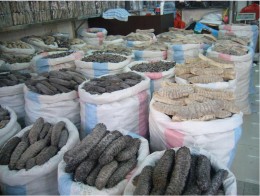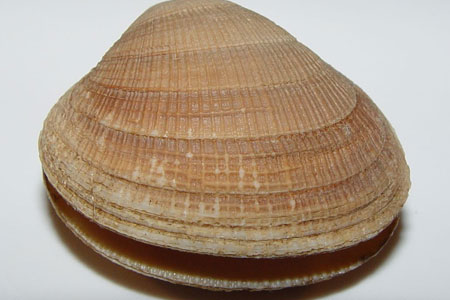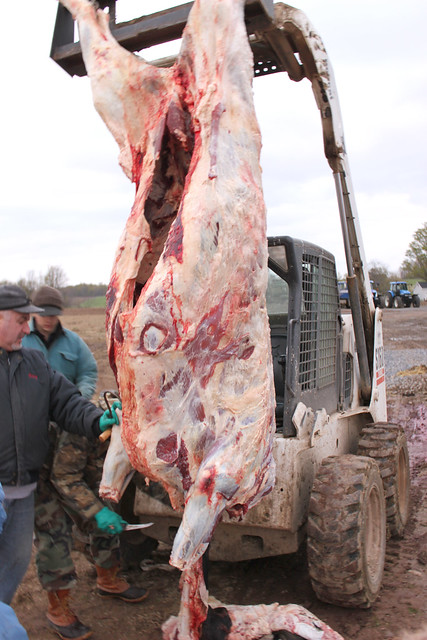Get your Slug On! F.O.G. Book Review! Fall Fishes!! Raw Clams!! Beef's Up! The Votes are In! The Urchins Won!!

We are true believers, now.
Dear Holothurian-Hugging Customers,
For years now we have offered sea cucumbers, or Holothurians, as they are properly known, along with our other dive products. We, of course, love and stand behind all our offerings, but Cukes have been a neglected, unsung and un-pushed sideline for us. That neglect ends right here, right now. Cukes are a major fishery in our inside waters--the combined state and tribal quotas this year top 700,000#. As with everything else Puget Sound, our local Cukes are considered to be the best on the market and command a premium in China. Almost none of them are eaten domestically. These past few weeks we have come to a whole new appreciation for Cukes. We have been feeding on them, reading on them and hereby dedicate this Fish-O-Gram to the delicious, nutritious and wondrous sea slug.
Cukes are Food.

Diner Fare
For years we considered sea cucumber to be another Asian culinary peccadillo like rhino horn or jellyfish--our few encounters with them were fairly unsatisfactory. As it turns out, we were going at it all wrong. Cucumbers turn up in every waterfront cuisine and culture. They are found in every body of salt water, in huge numbers. Some estimates hold that Holothurians, in all their manifold glory, all 1700+ species, represent the largest collective biomass in the oceans, with gigantic population in the deepest depths of the ocean floor. If true, Cukes would be the most abundant animal in the world. Cukes are harvested in near-shore fisheries world wide, and almost all the product ends up in Asia, with China being by far and away the largest buyer. This past week at the JFF test kitchen we went through a full bucket of Cukes. We had them boiled, fricasseed, stewed, country fried, casseroled, souffled, baked and poached. We are born-again. Cukes are flat-out delicious, extremely versatile, and just strange enough to be big fun.
Cukes are Medicine.

Good for what ails you
Cucumbers are widely used in Chinese medicine for a wide range of ailments including fatigue, digestive problems, arthritis, sexual complaints, depression, gingivitis, gum disease and cancer. Recent western medical research is backing up the notion that Cukes are in fact a superfood, especially in relation to cancer treatments. Chinese diners draw a distinction between wild and farm-raised cukes, with the wild commanding a premium both for flavor reasons and as wild Cukes are thought to be more potent. We here at Jones Ranch have been feeling much perkier since our Cuke-a-Thon. The only comparable lift is that we get from early-season nettle infusions. And that persistent itch has cleared right up…….
Cukes are Amazing.

Just add sunlight.
Everybody knows that cucumbers can expel their innards at will to confuse predators. They are also the largest animals to function without a brain. Cukes do have a ring of neural tissue surround their mouth, but when this tissue is cut out for science experiments, lobotomized Cukes continue to function. Cukes are detritivores, they chew through bottom deposits like earthworms work through humus on land. As such, Cukes, in tandem with the gigantic populations of mesopelagic fishes, are likely the largest driver in global carbon cycles and deep-water sequestration. Some species are capable of regulating their body density to allow them to rise through the water column. Some species can launch themselves through the water for as much as a mile on one pulse. Some species incubate their young and live-birth their offspring, while most Cukes are broadcast spawners with free-swimming larvae. Deep in the ocean vast herds of Cukes roam like the buffalo of yore on the Great Plains. They seem to coordinate their migrations, so as to constantly work fresh ground. Cukes are mildly toxic to most marine species--only humans and a few specialized predators eat them. One species is fully pelagic, meaning it swims and circulates with fishes and jellies. An Atlantic species, Elysia Chlorotica, has the ability to borrow photosynthetic chloroplasts, and borrow the DNA required to make more chloroplasts, from algae and themselves begin to photosynthesize. Young Elysiums only eat until they secure the needed DNA? Ever afterward, they are self-sufficient on solar power and they never use their digestive systems again.
Cukes are Historic, Popular and Profitable.

They're screaming for them in Shanghai.
Asian consumers have been on to Cukes for a very long time. The first documented trade contact with Australia involved a three cornered trade with Macassan traders winging between China, Sulawesi and Eastern Arnhem Land of North Australia. The Aboriginal Yolngu people exchanged dried cucumbers for Chinese made tools, textiles and tobacco as early as 1400 AD. Today Cukes are harvested world-wide. Puget Sound product generally garners the highest prices and greatest demand. Prices hit a high-water mark in 2013 with boat prices reaching $6.75#. At the time the inside quota was close to a million pounds, so we are talking real money. In Mexico, gun battles were reported amongst Cuke divers in the sea of Cortez, and we know of a tribal fisherman who outfitted his purse seiner to drag for Cukes. He was working in 500 ft of water, bringing up huge bags of cucumbers along with thousands of smashed crab and Volkswagen-sized boulders.
State and tribal managers swiftly nipped that one in the bud, but there is nothing like a fishery in boom-times to make for interesting stories. On the consumer side, one Puget Sound cucumber was reportedly worth upwards of $160 in China.. Word was a few years back that senior government officials and gangsters made a point of eating imported cucumber daily, just to prove they could.

The secret is a cuke a day
Almost every coastal nation is now engaged in large-scale cucumber farming, with the exception of the United States. In 2008 China produced 321 million dollars in aquacultured cukes. The figures now are likely at least twice that. Cukes are grown in tidal ponds or lagoons and fed cultured macroalgae.
Prices now are still robust, but the frenzy is off. High-end imported seafood became a symbol of government corruption in China, and incoming Chinese president Xi Jinping made Cukes a special target of a massive anti-corruption campaign. Imported Cucumbers have been hit with punitive tariffs and citizen activists now shame bureaucrats by posting cell phone videos of them scarfing Cukes. Of course, this means that Cukes, like Geoducks, are now being smuggled into the country through Hanoi and Hong Kong. Professional Cuke and Duck mules strap seafood to their undershirts with duct tape and walk across the border. This product now is now generally eaten behind closed doors. In this way millions of pounds of product makes its way into mainland China.
Cukes are poetic--F.O.G. book review.

F.O.G gets literary
The Japanese have long been eager sea cucumber consumers. Cukes are more than just food or just medicine for the Japanese. Cukes are considered to be masterful and wise, deep and desirable. An animal with no brain, which migrates in thundering herds, who processes detritus into some of the finest protein on earth. Cukes feature in cartoons, movies, novels, pop songs and religion, as well as in cuisine. Maybe best developed, though, is sea cucumber haiku.
F.O.G was delighted to stumble onto a compendium of translated Cuke-themed haiku. Titled, "Rise, Ye Sea Slugs" by Robin Gill. This book is a must have for any serious student of seafood culture. It includes such Holothurian trivia as the first recorded mention of Cukes in Japanese literature, Kojiki, or Records of Ancient Matters. In this tale, the Gods round up all the fish of the world and ask if they are ready to serve the children of the gods, better known as the Japanese. Only the sea cucumber does not respond, and so the Sun Goddess pulls out her knife and slashed the cucumber's mouth. This explains why Cuke mouths are so stark, no tongue, no lips, just an opening.
A few selections;
Cukes and You.

We do birthday parties, pony rides, haiku, clam shucking….
It is high time we here in the Puget Sound get on the Holothurian train. Surely we can develop a cucumber-culture on our fair shores. Maybe haiku is not going to happen, but why not Cuke Hip Hop? Not only are Cukes wonderful, but they are among the most available local seafoods. The tribes have wisely elected to spread out their Cuke quota by limiting harvest to two days a week. Our state divers are currently conducting a small mop-up fishery. Cukes are available August-June, always subject to weather, of course. If you find yourself entertaining corrupt bureaucrats, gearing up for a haiku slam, in need of a restorative tonic, or just want to wow your jaded customers, JFF’s got your slug!!! Our trained crew of Sea Slug-Costumed Mimes is also available to help stir up customer enthusiasm.
Fall-time fishes.

Big Kiss From Rhode Island
As we wend our way into the twilight of 2016 fresh salmon is becoming a memory, halibut is down to the last few hundred thousand pounds of quota, and west-coast bottom fish become a weather-chancy item. Black cod season is in full tilt, but is ever-subject to stormy conditions. Beyond the still bargain-priced crab, inscrutable Cukes, phenomenal urchins and the other deep-winter stalwarts, we have some seasonal delights from our Eastern Friends. Monk is ever popular, Black Sea bass begins November 1 and for a few weeks we are well set for Tautog. This northern wrasse has all the love of a southern fish and all the clarity of a Northern animal. Tautog is your best bet for shaking off those restaurant week blues. 8# average size round. Call today!
Half shell heroes!!!

Just Slide the Knife in the Gap.
For years now we have striven to produce enough littleneck clams to being pushing a raw clam option in the raw bars of Seattle. This lovely native clam has been largely left behind with the popularity of Manila and now Savory clams for steaming. These two species make excellent cooked clams, but are a little lacking in the raw. Half-shell clams are a staple of East Coast shuckers, but have not caught on in our far corner. We now have enough supply to begin pushing this culinary sensation and we aims to change all that. Littlenecks have a light, crunchy, crisp flavor that provides the perfect foil to a fine local oyster selection. Look for your JFF rep bearing clam samples in days to come! The key element in successfully shucking clams is to use a thin-bladed knife and cut down through the division of the shell, not to attack from the rear like an oyster.
Beef Coming.

Man Does Not Live by Cukes Alone.
Fish may pay the bills and fill our hearts, but we remain avid farm-folk here. This past Monday we butchered two chubby, luscious, entirely grass-fed beef from the Mainland Cattle Company. They will hang for two weeks then be cut to your specs. Look for a meat-themed Fish-O-Gram in coming weeks. Big news brewing on this front.
The Good Guys Won.

A Thorny Welcome for Cream Skimmers.
Last Fish-O-Gram we discussed a pending vote in the State Urchin dive fleet. The question at hand was whether to open red urchins with a weekly per-boat quota. This is important because with rising interest and pricing on urchins, the dive fishery is beginning to attract a Cream Skimmer population of divers. Our resident divers tend to focus on quality and price, and like to work steadily. Cream Skimmer operators hopscotch up and down the coast. They want to hit fisheries hard and fast, then move on to the next fishery and state. Cream Skimming thinking is the reason all but 14000# of the state Cuke quota was thumped in six weeks this summer. For Puget Sound urchin, this means harvesting huge volumes, as much as 5-6000# per diver, per day, and shipping them to California for processing and, primarily, export. Again, this is terrible for local access to the resource, and yields poor quality uni. The votes are in, and we are delighted to announce the state red urchin season will open Monday the 24th with an 1800# per boat, per week quota. So allocated, we will have Reds through the new year, the quality will be high, and the Cream Skimmers will stay in Alaska or head down the coast to California.
Until next time, we are, a phone call or email away, your Cuke-Cuddling, Bottom Crawling, Photosynthesizing, Politician Feeding, Haiku Spouting, Tautog Importing, Cow Killing, Urchin Electioneering, JFF Crew.
For customer service please reply to this email or call 360.468.0533

No comments:
Post a Comment